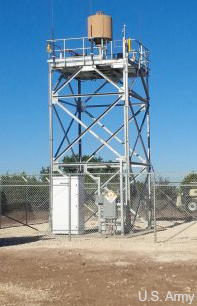Army installs first sense-and-avoid radar for drones
Fort Hood hosts the ground-based system, a step toward greater use of UAS in domestic airspace.
In a small but fairly significant step toward greater use of unmanned aerial systems in domestic skies, the Army has installed the first of five planned Ground-Based Sense-and-Avoid radar systems, this one at Fort Hood, Texas.

The complex system, which incorporates subsystems including 3D radar, known as LSTAR, along with data fusion, tracker and classifier systems, separation algorithms and more, helps meet Federal Aviation Administration requirements for domestic flight, although widespread use of UAS is likely years away.
The GBSAA system will replace the current method of meeting the FAA’s “see and avoid” requirement for aircraft, which in the case of drones consists of visual observation either from the ground or a chase plane. The system is designed to be compatible with any UAS (Fort Hood hosts a number of MQ-1C Gray Eagles) and will support the transition of UAS from airfields to restricted areas for training and testing.
"The GBSAA system has exceeded all of its performance requirements, from the test bed to the full system concept demonstrations and follow-on testing," Col. Courtney Cote, Army project manager for UAS, said in a release. "This system provides the alternate means of compliance with FAA regulatory requirements that will enable our Army to perform the critical mission training they need."
Sense-and-avoid technology is the key to wider domestic use of UAS, whether military or civilian. The military, of course, has used UAS extensively in the relatively uncluttered skies of Iraq and Afghanistan, but flying in the United States, where the air is densely populated with manned and unmanned aircraft, is another story.
Congress has given the FAA a 2015 target for integrating drones in domestic airspace, though realistic projections put the date at 2016 or even several years later.
Ultimately, the goal is to have sense-and-avoid systems on UAS themselves, rather than using ground-based radars. The Air Force, which has been working with contractor Defense Research Associates since 2001 on its Collision Warning Using Existing Sensors (CUES) program, in October gave DRA a $232.5 million contract to continue its work on developing a sense-and-avoid system that could be added to UAS without modifying the craft itself. Part of DRA’s work has involved miniaturizing its technology so that it could be used on smaller UAS, such as the Shadow, which has a 14-foot wingspan, in addition to larger aircraft such as the Gray Eagle.